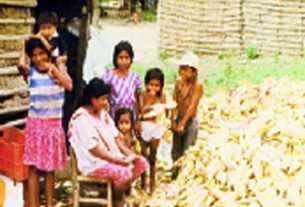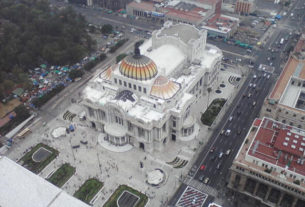Mexico, the United Mexican States (in spanish Estados Unidos Mexicanos), is a federal republic situated in North America. It is bounded on the north by the United States; on the east by the U.S., the Gulf of Mexico, and the Caribbean Sea; on the south by Belize and Guatemala; and on the west by the Pacific Ocean. Mexican federal jurisdiction extends, in addition to Mexico proper, over a number of offshore islands. The area of the country is 1,972,547 sq km, (761,604 sq mi).
The Land
Most of Mexico is an immense, elevated plateau, flanked by mountain ranges that fall sharply off to narrow coastal plains in the west and east. The two mountain chains, the Sierra Madre Occidental to the west and the Sierra Madre Oriental in the east, meet in a region called La Junta in the southeast. At La Junta the two ranges form the Sierra Madre del Sur, a maze of volcanic mountains containing the highest peaks in Mexico. The Sierra Madre del Sur leads into the Isthmus of Tehuantepec, which lies between the Bay of Campeche and the Gulf of Tehuantepec.
The prominent topographical feature of the country is the central plateau, a continuation of the plains of the southwestern U.S. Comprising more than half the total area of Mexico, the plateau slopes downward from the west to the east and from the south, where the elevation varies from about 1830 to 2440 m (about 6000 to 8000 ft) above sea level, to the north with an elevation of about 1070 to 1220 m (about 3500 to 4000 ft).
The coastal plains are generally low, flat, and sandy, although the Pacific coast is occasionally broken by mountain spurs. Baja California, a long, narrow peninsula extending about 1225 km (some 760 mi) south from the northwestern corner of the country, is traversed by mountains that are a continuation of the coastal ranges in the U.S. state of California. The Yucatán Peninsula, which forms the southeastern tip of the country, is low and flat, averaging about 30 m (about 100 ft) in elevation.
Mexico has few major rivers, and most are not navigable. The longest river is the Rio Grande (called the Río Bravo del Norte in Mexico), which extends along the Mexican-U.S. border. Other important rivers include the Pánuco, Grijalva, and Usumacinta in the south and the Conchos in the north. Mexico has few good harbors. Tampico, Veracruz Llave, and Coatzacoalcos (Puerto México) are major Gulf of Mexico ports. Pacific ports include Acapulco de Juárez, Manzanillo, Mazatlán, and Salina Cruz. Lake Chapala, in the west, is the largest inland body of water. The Valley of Mexico contains several shallow lakes.
The Climate
Mexico is bisected by the Tropic of Cancer; therefore, the southern half is included in the Torrid Zone. In general, climate varies with altitude. The tierra caliente (hot land) includes the low coastal plains, extending from sea level to about 914 m (about 3000 ft). Weather is extremely humid, with temperatures varying from 15.6. The rainy season lasts from May to October.
Although sections of southern Mexico receive from about 990 to 3000 mm (about 39 to 118 in) of rain a year, most of Mexico lacks adequate rainfall. Rainfall averages less than 635 mm (25 in) annually in the tierra templada, about 460 mm (about 18 in) in the tierra fría, and about 254 mm (about 10 in) in the semi arid north.
Natural Resources
The mineral resources of Mexico are extremely rich and varied. Almost every known mineral is found, including coal, iron ore, phosphates, uranium, silver, gold, copper, lead, and zinc. Proven petroleum and natural-gas reserves are enormous, with some of the world’s largest deposits located offshore, in the Bay of Campeche. Forests and woodland, which cover about 23% of the land, contain such valuable woods as mahogany, ebony, walnut, and rosewood. About 13% of the land is suitable for agriculture, but less than 10% receives enough rainfall for raising crops without irrigation.
Flora and Fauna
Because of the wide range of temperature, the native flora of Mexico is extremely varied. Cactus, yucca, agave, and mesquite are plentiful in the arid north. The tierra caliente is thickly grown with an immense variety of plants, which form a dense tropical jungle in some areas. The trees in this zone include valuable hardwoods, as well as coconut palms, gum trees, and almond, fig, and olive trees. On the mountain slopes grow oaks, pines, and firs. Arctic vegetation is found at the highest altitudes in Mexico.
Mexican fauna also varies according to the climatic zones. Wolves and coyotes are found in the north. The forests on the mountain slopes are inhabited by ocelots, jaguars, peccaries, bears, and pumas. Fur-bearing seals are found on the coasts. A wide variety of reptiles includes turtle, iguana, rattlesnake, and lizard. Birds, including sea and game birds, are numerous. Along the coast and in the estuaries of rivers fish abound.
Population
The Mexican population is composed of three main groups: the people of Spanish descent, the Indians, and the people of mixed Spanish and Indian ancestry, or mestizos. Of these groups, the mestizos are by far the largest, constituting about 60% of the population. The Indians total about 30%. The society is semi-industrialized.
The population of Mexico at the 1990 census (preliminary) was 81,140,922. The estimated population density in 1990 was 41 persons per sq km (107 per sq mi). About 73 percent of Mexicans lived in urban areas.
Political Division
Mexico consists of 32 administrative divisions — 31 states and the Distrito Federal (federal district), which is the seat of the federal administration.
1.Aguascalientes,
2.Baja California,
3. Baja California Sur,
4.Campeche,
5.Coahuila,
6.Colima,
7.Chiapas,
8.Chihuahua,
9.Distrito Federal,
10.Durango,
11.Estado de Mexico,
12.Guanajuato,
13.Guerrero,
14.Hidalgo,
15. Jalisco,
16. Michoacán,
17. Morelos,
18. Nayarit,
19. Nuevo Leon,
20. Oaxaca,
21. Puebla,
22. Querétaro,
23. Quintana Roo,
24. San Luis Potosi,
25. Sinaloa,
26. Sonora,
27, Tabasco,
28. Tamaulipas,
29. Tlaxcala,
30. Veracruz,
31. Yucatán,
32. Zacatecas.
The National Flag
The meaning of the colors of the Mexican flag is:
Green: Hope. Fertility of the soil.
White: Purity.
Red: For the blood shed during Independence.
According to the legend, the Aztecs in search of their promised land, were told by their god Huitzilopochtli, that when they would find the eagle devouring a serpent on a nopal cactus treee, they were to settle down in that place and found Tenochtitlan, which is today Mexico City.
Principal Cities
The capital and cultural center of the country is Mexico City, with a population (1980) of 9,981,000.
Other important cities are Guadalajara (2,178,000), a vital mining center;
Monterrey (1,702,000), an industrial area and railroad center;
Puebla (771,000), one of the oldest cities in the country and a pottery manufacturing center;
Ciudad Juárez (680,000), a commercial and manufacturing center;
Leon (596,000), the center of an agricultural area;
and Tijuana (542,000), a tourist as well as an industrial center.
Religion
Roman Catholicism is the faith of more than 90 percent of the people. Mexico’s long tradition of official anticlericalism ended in 1991 with the passage of constitutional changes granting legal status to religious institutions and allowing parochial schools. Protestants represent a small but growing minority in Mexico.
Language
The prevailing and official language is Spanish, which is spoken by the great majority of the population. Indian languages number about 13, with many different dialects, the chief of which is Nahuatl (see American Indian Languages), or Aztec. Other major dialects include Maya, spoken in the Yucatán Peninsula, and Otom’, common in central Mexico. Successive governments have instituted educational programs to teach Spanish to all of the Indians.
This article is electronically reproduced with permission from the Mexico 2000 Business Directory .
Your Passport to Mexican Business.
SPONSOR:


